Text by Laura Netz
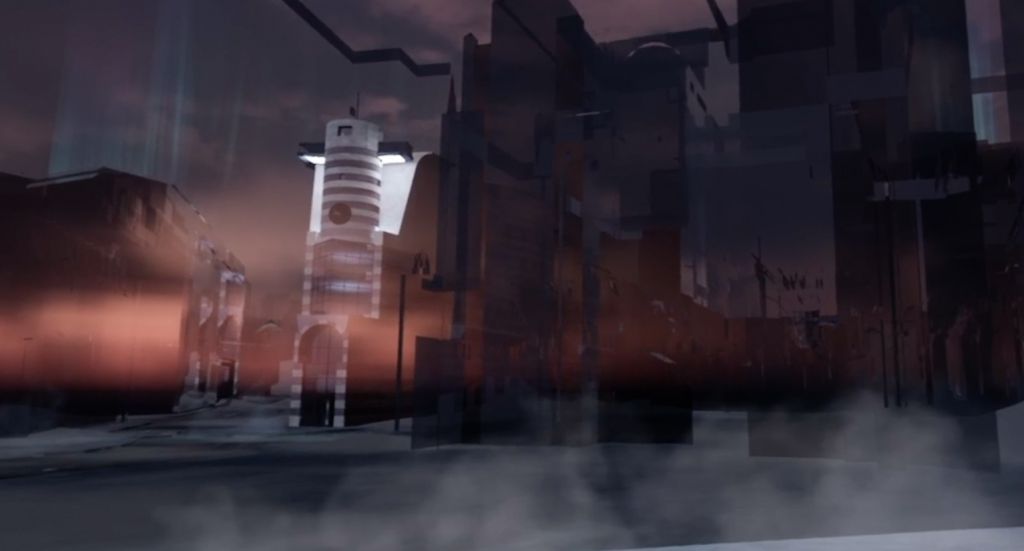
The work in The Underlying utilises live sentiment analysis of online news production and social media, relating to BPA’s (Bisphenol A*) to consider how surveillance, rather than a rogue element of capitalism, enmeshes with the effects of market forces upon the environment, happening at a molecular level.
Set in a parallel present, The Underlying draws out the failures of the current system to deal with the impending climate crisis as the future comes up increasingly short. The financiers’ tool of live sentiment analysis of the news drives an 8-screen video work, focusing on the current predicament that shows the BPA molecule (Bisphenol A) – a synthetic oestrogen and byproduct of plastic production – polluting the planet at a molecular level.
Sited in the City of London, just outside of 1 Poultry, the Virtual Reality work questions how ‘virtual’ the effects of the markets are on the environment, as data from the sentiment analysis influences the sandstorm polluting the landscape at the financial heart of the British nation-state, born of tax evasion and offshore banking.
The sand escapes from the virtual landscape as an enormous drift amasses up against the windows of the gallery, where outcrops of spawn-like prosthetic eyes, reminiscent of surveillance capitalism, remain evocative of collective potential.
The Underlying is a new body of work by Ami Clarke at arebyte gallery that includes: Lag Lag Lag (8-screen video interface with live sentiment analysis), Derivative (Virtual Reality with live sentiment analysis), The Prosthetics (prosthetic optics, blown glass), and sand drift installation.
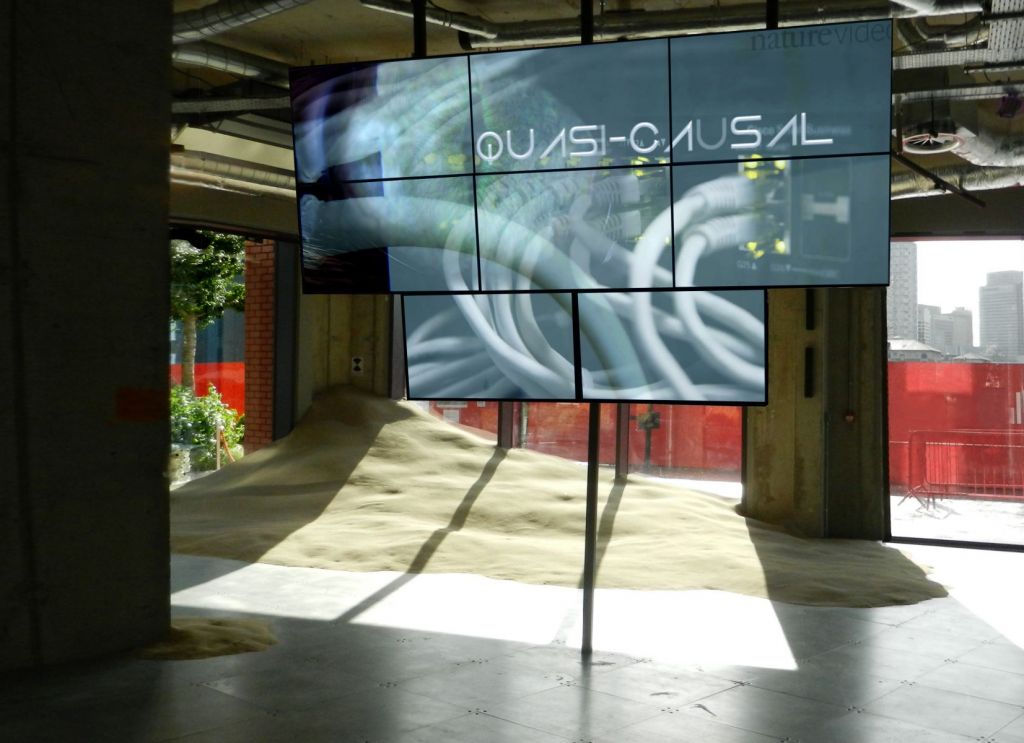
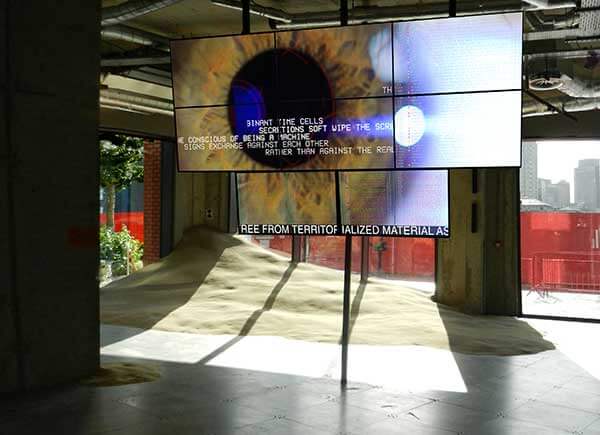
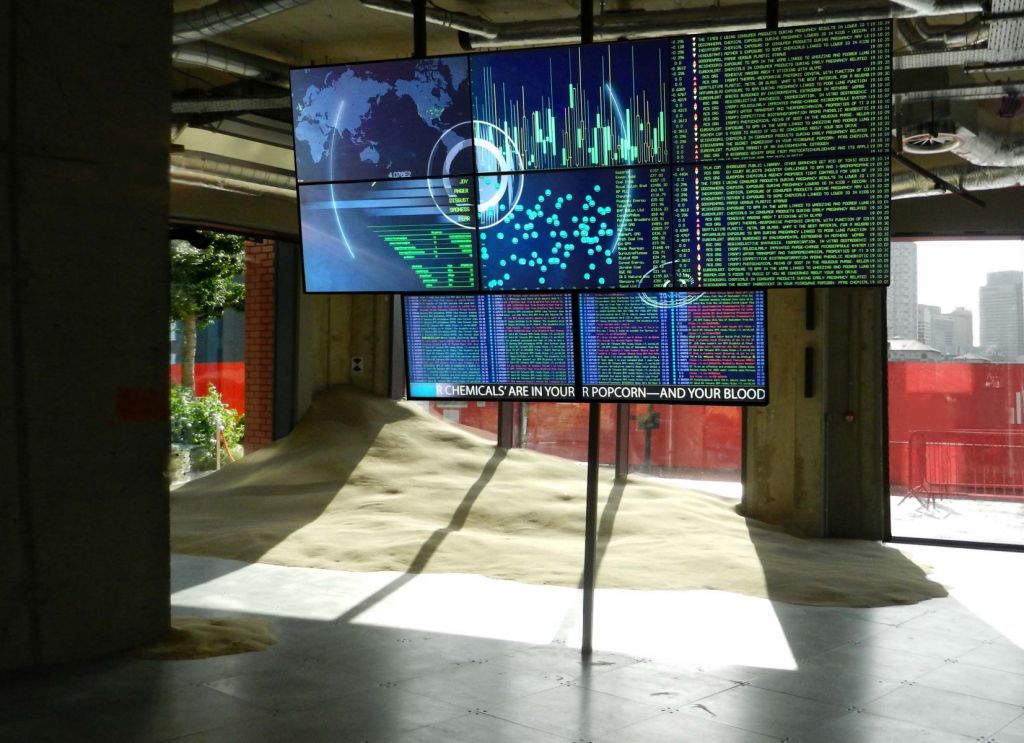
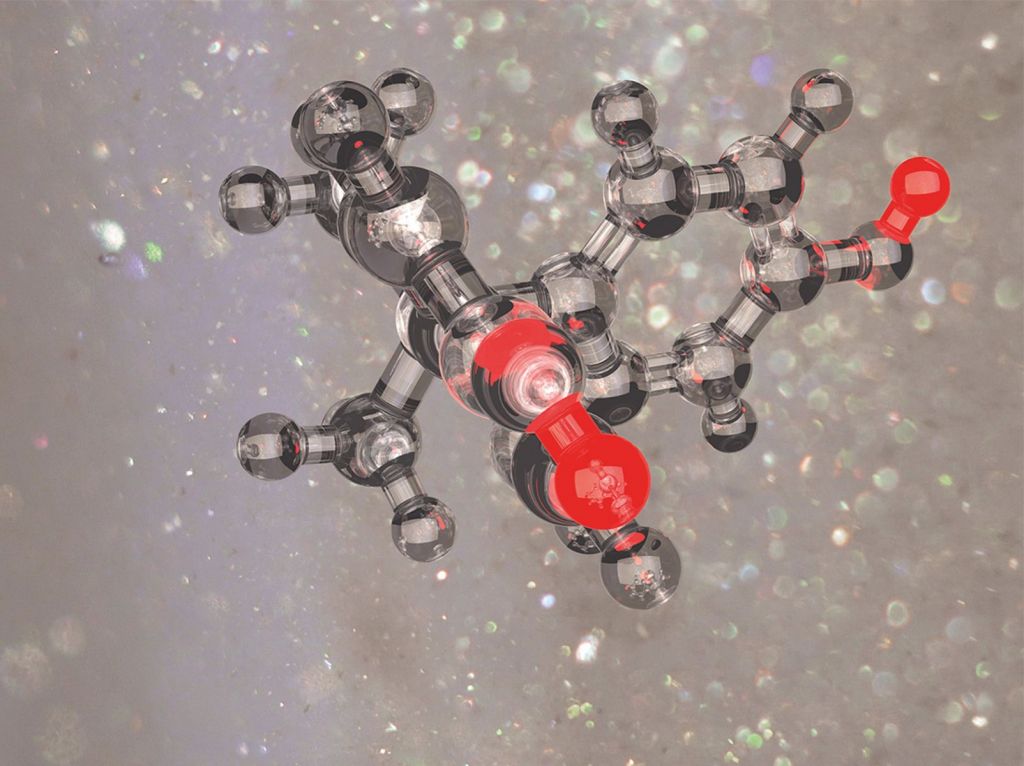

You introduce the work via the context of the contractual condition of both finance and insurance, saying it reveals the negative effects of capitalism on the environment through a relationship with the past, which indicates that the future is coming up increasingly short. Your work on speculation in language and the economy has led you to this, I believe, and you mention that the current state is one whereby ‘contingency’ becomes a modus operandi. Can you speak a little about what you mean by this?
My works have been focused on speculation in language and the economy for a while now – finance interests me as it affords a glimpse of a highly volatile and paradoxical model of mass behaviour and has been the focus of cognitive bias research for some time. It also provides a focus on the economic underpinnings of everything from the subprime mortgage crisis to Brexit, at a particularly fraught time of hyper-financialisation of quite literally everything, via neoliberalism.
The figure of homo economicus as a deeply in-debted subject is also interpellated through the highly quantified protocols of platform capitalism and a lifeworld increasingly seen as a system for the notation of market trend data. I don’t think it’s a coincidence that the de-regulation of neoliberalism kicked in around the same time as environmental concerns in ’88, so I wanted to grasp some of these ideas as they converge in the current moment.
The mechanisms of insurance and the derivative contract have this inevitable form to them, dragging the past into the future through predictable outcomes, inherently via an act of writing. This draws on a previous work of mine, Ami Clarke: Author of the Blank Swan, in which I wrote, word for word, the fourth chapter of Elie Ayache’s book (the French Lebanese financier and Philosopher): The Blank Swan, which was focused specifically on the contractual condition of the derivative.
Ayache was at pains to re-introduce contingency back into the philosophical canon, finding equivalence in writing, to pricing, in the derivative markets, (similarly shared across the blockchain, which I’ve written about in Artists Rethinking the Blockchain), and hence opening up a capacity to ‘write’ the future, as he puts it.
So there’s this idea that contingency brings about something entirely unexpected that you cannot foresee, and hence, breaking with the past, if you like – in which the future is radically open – as Karen Barad would say.
Exciting stuff, you might think, unless this mode of operandum becomes a daily occurrence, and ten impossible things happen before breakfast… sound familiar?
I’ve tried to grasp something of the complexities, multi-temporalities and scales that coalesce around these new and very old power relations that come of, and are revealed by, the technologies associated with the interdependent ecologies of social media, finance, and the environment, in this work. The contractual condition of both the derivative and insurance draw out a story that Britain wants to forget, central to the climate crisis, as neoliberal profiteering via free market ideologies runs historically through seams of colonialist extraction to digital neo-colonialism. The futures markets meet behavioural futures.
The meme that is capitalism, ‘platform’, ‘surveillance’, late, as well as ‘disaster’, and the free market ideologies that underpin this are based explicitly upon these extractive relations. The underlying: assets that come from land theft, slavery, and resources, come from an extractable relation that inscribes race, and ongoing inequalities, with legacies to be found in geographical locations with projections of the most volatile environmental futures.
Here, ‘contingency’ means being in a constant state of emergency – a state of constant readiness for the worst – shared across the media sphere (via strategies of disinformation) and the markets – contingency becomes a modus operandi – the operative feature of disaster capitalism.
You work with the idea of multi-temporalities, which is not only related to material resource extraction but also to a financial system based outside of the normal jurisdiction of the UK, predating democracy from the medieval era. You refer to it as neo-feudalism. What does this mean exactly? Is this related to offshore tax havens?
The VR work is sited around Bank within the City of London Corporation for historical reference, whilst the new epicentre of banking appears to be in sight of the gallery through the windows of the gallery. But, the innocuous-looking server buildings just across the way from London City Island speak more of the high-speed trading that goes on today, as well as housing the routers servers and another massive building that facilitates UK internet worldwide comms (John Wild’s Dark Fibre Network Drift is really great for finding out more about this if you’re interested).
When you enter the VR landscape, you land outside 1 Poultry, right by this monument to post-modernism, in the heart of the city. The VR points to the ancient semi-alien entity lodged inside the British nation-state in the form of the City of London Corporation – that exists outside of parliament’s normal legislative remit – an offshore city within a city – with the UK by far the biggest enabler of global corporate tax dodging (groundbreaking research: The Corporate Tax Haven Index by the tax justice network finds1).
There’s a reason the Brexiteers don’t want more transparency around their financial affairs that EU legislation is keen to introduce. The research highlights a widely acknowledged but fundamentally unsolved situation that points to “the role of the UK and its network of Overseas Territories and Crown Dependencies in undermining the ability of other countries, including some of the poorest in the world, to provide for the most basic rights of their citizens.” This is where the current moment crystallises around wealth derived from a relation that inscribes ongoing inequalities.
It’s where the secret sauce of memetic media meets the magic sauce of right-wing billionaires, underwriting political campaigns to facilitate a wholesale move to the hard right, as various survival strategies emerge, as the planet continues to heat up, facilitated to a greater or lesser degree by the ‘freedom’ that blockchain supposes in terms of citizenship, as progressives and the alt-right meet, and Davos man doubles down for the long game, to ride out the winter of democracy altogether.
Your video Lag Lag Lag seems to criticise the effects of social media in the capitalist market and how this news can destabilise financial transactions. Can you explain how algorithmic governance is influencing financial capitalism?
Previous works focused on behaviours common to both the digital/analog assemblage through which news emerges, via the loss of the referent in both languages and the economy and the financial assemblage of HFT that Katherine Hayles picks up on in her recent book Unthought – the results of which went on to undermine democracy itself. Cries of ‘fake news’ that characterize the times are by no means new, but in this era, facilitate the gaming of who has the authority to speak.
During my research, I spoke to the managing director of the sentiment analysis software RavenPak, who was at pains to assure me his data was quality goods – none of your fake news muck – which is why they’ve prices starting at £10K p.a., as they plot the rise and fall in market reputation. It’s no coincidence that in stark contrast, it’s also an era also characterised by ‘shamelessness’, indicative of issues regarding class and privilege, perceived or otherwise.
I’d come across the financiers’ tool of sentiment analysis whilst working on Low Animal Spirits and Breaking News – Flash Crash in 2013/14, and I wanted to utilise this key mechanism of our hyper-connected times – where machine learning evaluates joy, anger, fear, disgust and sadness, from Twitter, and online news production – in a performative way, whereby the value derived feeds the work in a critical sense.
The 8-screen video work conjures the interfacial regime of the financier, though, which, you might say, all other value is measured. The pricing model, built by ex-derivatives trader Jen Elvidge with programming by Rob Prouse, develops a live interface in the gallery space analysing news relating to BPA’s to map the rise and fall of reputation in real-time, using weather futures contracts, pollution data, and the FTSE to plot the fluctuations in the stock prices of the top 100 polluting companies in the world, responsible for over 70% of emissions.
It utilises a quantitative financial model that takes BPA sentiment analysis, the FTSE (as a proxy for the general stock market), and CME Weather Futures contracts from the Chicago Mercantile Exchange that map the weather at London Heathrow, used to settle weather futures contracts, as well as pollution data taken from the lattitude and longitude of the gallery.
The model is entirely speculative but anticipates the moment when the 100 most polluting companies will find that their investments in coal, gas and oil have become stranded assets, as public pressure means these fuels simply need to stay in the ground. The insurance industry comes back into play here, as it’s by far the largest investor in fossil fuels right now and, as a result, could play an important role in stopping these investments altogether, although thus far, they’ve not exactly taken up the challenge.
Can you say more about the scale of certain material aspects of the work – that seems to come out in your focus on BPA in particular, drifting in and out of focus throughout the work?
A toxin and synthetic oestrogen, BPA’s are particularly good at binding with humans, produced during plastic production since the ’30s – now quite literally flooding the world’s water supplies. There’s a HUD screen in the VR that shows live readings of the sentiment/emotion analysis that influences more airborne particles being produced within the environment of the VR.
I’m perhaps fascinated by Bisphenol A in particular as I’ve recently gone through menopause and was thinking back to when I have prescribed 6 times the dose of synthetic oestrogen during adolescence, at the Tall Girls Clinic, at the Department of Growth and Development, Great Ormond st Children’s hospital, in a desperate bid to stop my growing.
At a very basic level, possibly subliminal, I was aware that xenoestrogen was some kind of technology as I emerged from this biochemical prosthesis into adulthood. I kept thinking of Preciado’s emphasis on reworking Foucault’s history of sexuality (for Foucault was no feminist), and how biopolitical forms of government play out in what they describe as the pharmacopornographic era, with progesterone and oestrogen becoming best sellers in the history of pharmacology, and key elements of global capitalism.
In this panopticon, molecular entanglements enmesh with Deleuze’s modulatory control of data, as sentiment analysis mines Twitter’s ‘firehose’ and a sophisticated scoring of the relationships between words in the play, uncovering grades of expressed ‘emotions’ as well as importance and social meaning – in order to ‘predict the present’ and thus transform social media signals into economic information and value2.
Can you talk about the use of popular sci-fi aesthetics in your VR work Derivative?
As the remains of hurricane Ophelia made itself known via the orange skies above London in 2017, where we’re used to relatively bland weather, everyone made the same Bladerunner joke on social media. I’d been reading Sylvia Wynter’s writing on the combination of mythoi and bios, where she describes a concept of human narrans, and it struck me anew how important the stories were that people were telling each other right now, weaving fact and fiction to political ends.
The VR work Derivative draws from the popular imaginary of film productions but is located amongst the City of London’s financial district for something more akin to ‘Bladerunner 2019: the burnout’ in the year the first film was set. The replicants in Ridley Scott’s Bladerunner had been important to me, growing up, toying with ideas of AI that were deliberately left ambiguous, as Deckard’s status is never revealed.
The 2049 film lost this nuance almost entirely, through its emphasis on biological determinism, despite the implicitly hybrid nature of the child. I was keen, also, to emphasise writing as a technology – the prevailing thesis of ‘Error-Correction: an introduction to future diagrams’ (2010- ongoing) – points to how any ‘subject’ to speak of is constituted through other people’s words.
A question for the ‘eye that remains of me that was I’, as to how the subject is constituted politically, how much this relies on access to reliable information, how much is swayed by loyalty to a cause, for example. It’s deeply rooted in what Wynter points to in her writing, the question of how the ‘referent-we’ arrives. As such, writing from Error-Correction seeps into the rolling news feeds and other texts as the monitor work weaves both video and live data within its interface.
The multiple layering of technologies in the work, both analog and digital, I hope, speak to this posthuman complexity, as the subject emerges inextricable from the hardware, the software, the tools, the governmental policies that decide on whether to act on emissions data, for example, or not. Here, any subject to speak of emerges via an untrustworthy body with faulty equipment, produced in synthesis with its environment, that feels through the prosthesis, with a body that matters, without mattering.
Here, the posthuman subject, in all its complexity, refutes any notion of natural versus artificial, or indeed, any binary at all, prioritising a hybrid approach in all things. Although always flawed, it affords scrutiny to the contributing factors to specific assemblages emerging throughout history that construct gender, race, class, sexuality, and ableist bias’ and discrimination. Whilst any claims to universality are troubled with a crucial criticality that questions the humanist project for only ever having afforded some human rights and not others.
You put much emphasis on individual consumer responsibility in the ecological crises. How is the subject redefined in this new context of posthuman and becoming a cyborg?
Whilst much emphasis is put upon the individual as a consumer with the suggestion that lifestyle choices might bring about the dramatic changes necessary to avert environmental disaster, the extractive principles of capitalism that point to colonial pasts and digital presents remain unchallenged.
In contrast, the work in the exhibition seeks to position the subject emerging in synthesis with their environment, which sites the individual enmeshed within collective action through expanding mutual ecologies that include environmental concerns, as well as the contemporary digital milieu.
It is absolutely necessary to think of things at the level of structural and political change now; that would also mean it were possible not just to reproduce the extractive principles of yore but as well as tackle more recent problems arising from both the false claims of neoliberalism and austerity.
Some of the events concentrated on transfeminism, geo-communism and postcolonial discourse. Can you please develop these a bit more these definitions?
I was keen to invite people to contribute to the conversation, and during the Art Licks Weekend this year, they had a focus on interdependence, which seemed apt. I invited Arun Saldanha and Diann Bauer to join me in conversation, who, in their own way, seek to address the current power relations of catastrophic capitalism and the structural injustices that come of this via gendered, racialized and sexualised oppression.
It was an opportunity to think about potential alternatives to the current political malaise, as politicians seem so utterly unable to bite the bullet. I wanted to emphasise that people had been thinking about problems such as these for quite literally decades, if not centuries, prior to this moment being perceived as a moment of ‘crisis’.
Diann Bauer is part of the Xenofeminst group Laboria Cuboniks and the Alliance of the Southern Triangle (A.S.T.). An initiative exploring how artistic and cultural possibilities can be reimagined in the context of climate change, it began as a research project in 2015 focusing on the idea of the global city, using Miami and South Florida as its case study, committed to the idea that urban developmental trajectories can be altered through the adaptation of the networks that shape it.
Arun Saldanha wrote the Geo-Communism manifesto in 2013 that I’d been reading. He talks about how his theoretical research on the question of race brought him to consider vastly different fields, like environmental justice, climate change, philosophy of biology, Marxism, and political theory – thinking about how racial capitalism and the Anthropocene emerged in the cauldron of genocide against indigenous peoples, plantation economies, and the monopolist state companies.






